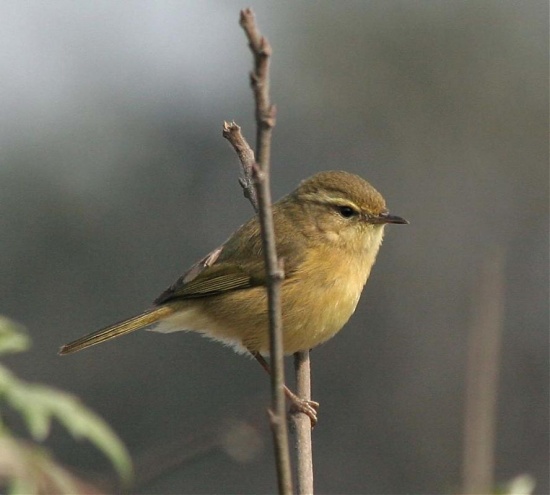- Horornis flavolivaceus
Identification
12–13·5 cm (4¾-5¼ in). A medium sized bush-warbler with short, rounded wings and average tail length, perhaps the most phylloscopus like shape wise in the region.
- Yellowish olive-green upperparts
- Pale yellowish supercilium
- Narrow whitish eyering
- Dark eyestripe
- Buffish or ollive-yellow underparts, darker olive on breast and flanks (variable)
- Dark eye
- Dark horn-brown bill, pale pink base of lower mandible
- Yellow to dusky pinkish-brown legs
Sexes similar. Juveniles are similar to adults but have uniform buffish-yellow underparts.
Variations
- alexandri with olive-brown upperparts but darker olive-buff underparts than nominate and with buffish breast and flanks
- weberi with strong rufescent-brown wash above and below, longer tail and ochre-brown breastband and flanks
- intricata is similar to weberi but paler and less yellow on underparts
- obita is similar to intricata but smaller and with brighter olive upperparts, washed pale yellow underparts and rufous-ochre flanks

Photo © by Jason Bugay Reyes
Kinabalu National Park, Sabah, Malaysia, Borneo, March 2008
Similar species
Greener (not rufous) upperpart than Yellowish-bellied Bush Warbler without rufous wingpanel and yellowish (not grey) throat and breast. Differs from Brownish-flanked Bush Warbler in yellower supercilium obvious before eye, greener upperparts having the same colour like crown and yellowish underparts tinged olive on breast and flanks.
Distribution
India and China east to Vietnam and Thailand as well as Greater Sundas and Lesser Sundas.
Common to fairly common in parts of its range.
Taxonomy
Formerly placed in genus Cettia.
The first eight subspecies were formerly considered a separate species, the Sunda Bush Warbler.
Subspecies
Clements recognizes these subspecies[1]:
- H. f. sepiarius:
- Mountains of northern Sumatra
- H. f. flaviventris:
- Mountains of central and southern Sumatra
- H. f. vulcanius:
- H. f. kolichisi:
- Alor (Lesser Sundas)
- H. f. oreophilus:
- Northern Borneo (Mount Kinabalu)
- H. f. banksi:
- Mountains of northern Borneo (Sabah and Sarawak)
- H. f. palawanus:
- Mountains of Palawan (south-western Philippines)
- H. f. everetti:
- Timor (eastern Lesser Sundas)
- H. f. flavolivaceus :
- H. f. stresemanni:
- North-eastern India (Garo and Khasi hills of Assam)
- H. f. weberi:
- H. f. intricatus:
- H. f. oblitus:
Former subspecies alexandri is considered a synonym of weberi.
Habitat
Found in bushes, tall grass clumps, ferns, dense bamboo thickets and scrub undergrowth in forest clearings and egdes of forest.
Breeds at 2400-3950 m in the Himalayas, up to 2900m in northeastern Indian hills and between 1200 m and 4900 m in China. At lower elevations in non-breeding season.
Behaviour
A shy and secretive species, often skulking for long periods in thick vegetation.
Has a distinctive habit of continually flicking wings and giving grating call when alarmed. Tail often slightly raised.
Diet
Not well known, feeds probably on invertebrates and larvae.
Forages low in dense vegetation.
Breeding
Poorly known. Breeding season from May to August. The nest is a ball made of dry grass, bamboo leaves and feathers. It's placed on the ground or low down in a clump of tall grass. Lays 3 to 4 eggs.
Movements
An altitudinal migrant, moves to lower elevations after breeding.
References
- Clements, J. F., T. S. Schulenberg, M. J. Iliff, T. A. Fredericks, J. A. Gerbracht, D. Lepage, S. M. Billerman, B. L. Sullivan, and C. L. Wood. 2022. The eBird/Clements checklist of Birds of the World: v2022. Downloaded from https://www.birds.cornell.edu/clementschecklist/download/
- Gill, F, D Donsker, and P Rasmussen (Eds). 2023. IOC World Bird List (v 13.2). Doi 10.14344/IOC.ML.13.2. http://www.worldbirdnames.org/
- Del Hoyo, J, A Elliot, and D Christie, eds. 2006. Handbook of the Birds of the World. Volume 11: Old World Flycatchers to Old World Warblers. Barcelona: Lynx Edicions. ISBN 978-8496553064
Recommended Citation
- BirdForum Opus contributors. (2025) Aberrant Bush Warbler. In: BirdForum, the forum for wild birds and birding. Retrieved 2 May 2025 from https://www.birdforum.net/opus/Aberrant_Bush_Warbler
External Links
GSearch checked for 2020 platform.1




